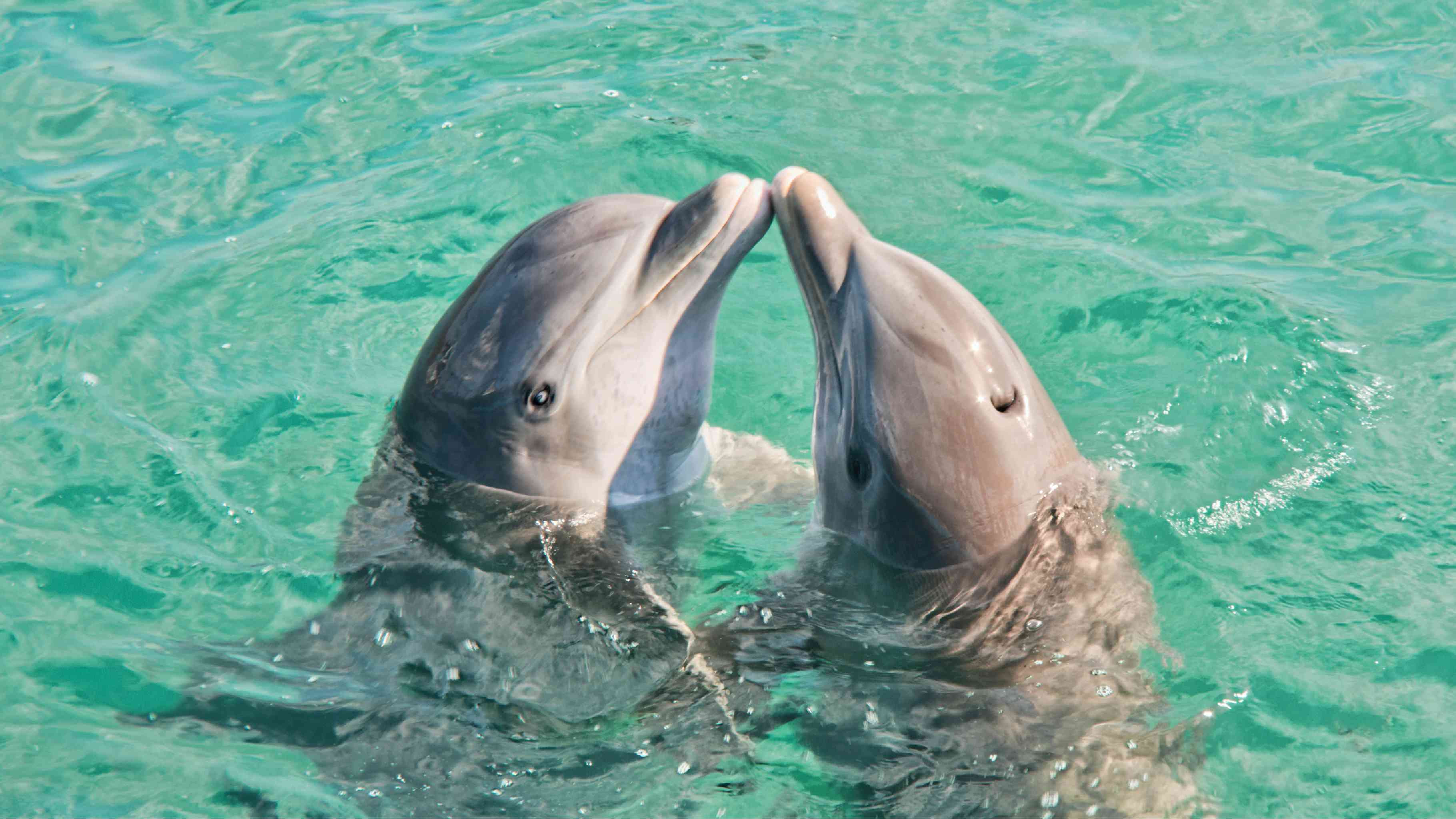Do Dolphins Have Names? Discover Dolphin Communication and Signature Whistles
Have you ever wondered, do dolphins have names for each other? It might sound like something from a cartoon, but scientists have found that dolphins are smarter than we ever imagined. In fact, some researchers believe that dolphins use special sounds to identify one another. That means they may have names, a unique form of dolphin communication! Let’s discover Dolphin Communication and Signature Whistles.
Dolphins and Whistles: Understanding Dolphin Communication
Dolphins communicate with each other using clicks, squeaks, and whistles. One special kind of sound they make is called a “signature whistle.” Each dolphin has its own unique whistle that no other dolphin uses. This is similar to how each person has a different name. These signature whistles are a big part of how dolphins talk and identify each other.
How Do We Know Dolphins Use Signature Whistles as Names?
Scientists recorded the whistles of wild dolphins and played them back through underwater speakers. When a dolphin heard its own signature whistle, it responded right away. But when it heard a different dolphin’s whistle, it did not react the same way. This tells us that dolphins know their own whistle and also know the sounds of others.
In some studies, dolphins even copied the whistles of others when they were calling out to them. This suggests that dolphins may say each other’s names to get attention. It’s like when we call our friend’s name across a crowded room. That’s one more clue that answers the question: do dolphins have names?

Why Dolphin Names and Communication Matter in the Ocean
In the wide ocean, dolphins often live in big groups called pods. They need to keep track of who is around. Having a name helps dolphins stay connected with their family and friends. It also helps them find each other if they get separated.
Dolphins don’t always stay in one group. They sometimes swim with different pods, like visiting friends or traveling with others for a while. In these cases, being able to recognize and call each other by name may be very helpful.
Dolphins Are Like Us: The Power of Dolphin Communication
Just like humans, dolphins are social animals. They talk to each other, play together, and even help each other when one is hurt. Using names is just one more thing that makes them feel a little more like us.
They also learn from each other and remember past experiences. Some dolphins have been seen solving problems as a team, sharing food, and teaching their young how to hunt. All of this shows that dolphins have strong bonds and need ways to stay in touch. Dolphin communication plays a big role in how they live and care for each other.
What Makes Dolphin Communication Special?
Dolphins live in a noisy world. Waves crash, boats pass by, and many other sea creatures also make sounds. So dolphins have developed very clear and unique ways to talk over long distances underwater.
Their signature whistles are just one part of their communication. They also use body language, touch, and even jump or spin to share messages. Some scientists believe they may use something close to a language. Understanding how dolphins communicate helps us see how truly intelligent they are.
FAQ:
Q: Do all dolphins have a unique name?
A: Yes, each dolphin has a unique signature whistle, which acts like a name.
Q: Can dolphins recognize each other’s names?
A: Studies show dolphins respond to the signature whistles of other dolphins they know.
Q: How do dolphins learn their names?
A: Dolphins likely learn their whistle from a young age and use it throughout their life.
Q: Is this the same as human language?
A: Not exactly, but it’s a complex communication system that shares some similarities.
So, do dolphins have names for each other? Yes, they probably do! Their signature whistles are like names that help them stay in touch and recognize each other in the vast ocean. Dolphin communication is a fascinating subject, showing how social and smart these ocean creatures really are.
Plan Your Adventure in Oahu, Hawaii
Learning about dolphins is fascinating, but seeing them in person is unforgettable. Our guided Dolphins and You tour lets you experience these amazing animals in their natural habitat. Whether you’re traveling with family, friends, or solo, this adventure is perfect for all ages.
🐬 What to Expect:
- Dolphins Watching: Watch wild spinner dolphins in their natural habitat along beautiful west Oahu waters
- Turtle Snorkeling & Marine Life: Swim alongside Hawaiian Green Sea Turtles, colorful reef fish and sometimes manta rays
- Water Adventure Extras: Soar down a thrilling 20-foot waterslide into the sea! Enjoy kayaking and stand-up paddleboarding on calm ocean waters
- Hawaiian Cultural Experience: Enjoy a traditional Hawaiian ceremony and authentic hula performance as part of your tour experience!
- Complimentary Lunch: Savor a delicious, included lunch while relaxing on deck
Reserve your spot today and experience why so many visitors say it’s the highlight of their Hawaii trip! Ready to Meet the Dolphins? Book your Dolphin Watching Tour now and create memories that last a lifetime.
Looking for more sea life facts? Check out our blog on how to tell male and female sea turtles apart!
 Bonus: More Fascinating Dolphin Facts You Might Not Know
Bonus: More Fascinating Dolphin Facts You Might Not Know
1. Dolphins Sleep with One Eye Open
Dolphins are conscious breathers, meaning they have to stay aware to breathe even while resting. To manage this, dolphins sleep by shutting down one half of their brain at a time. While one side rests, the other stays alert, allowing them to breathe and keep an eye out for predators.
2. Dolphins Teach and Learn from Each Other
Young dolphins learn skills from their mothers and other adults in their pod. For example, some dolphins have been observed using marine sponges to protect their noses while foraging on the ocean floor—a behavior passed from one generation to the next.
3. Dolphin Brains Are Surprisingly Complex
Dolphins have large brains with a neocortex and limbic system that support advanced problem-solving, memory, and emotions. In fact, their brain-to-body size ratio is second only to humans.
4. They Use Bubbles to Play and Communicate
Dolphins have been seen blowing bubble rings and playing with them just for fun! Some researchers believe these bubbles could also be a visual form of communication among dolphins.
5. Meet the Hawaiian Spinner Dolphin
One of the most iconic species in Hawaii is the Hawaiian spinner dolphin, known for its playful nature and incredible spinning leaps out of the water. These dolphins are often seen resting in shallow bays during the day and hunting offshore at night. Spinner dolphins live in tight social groups and use whistles and body movements to stay connected. Their acrobatic spins may serve as a way to communicate, remove parasites, or simply have fun!
Visitors to Oahu often have the chance to see Hawaiian spinner dolphins during eco-friendly boat tours. Watching them leap and spin is a magical experience and a reminder of just how alive and joyful the ocean can be.
6. Conservation Matters: How You Can Help Protect Dolphins
Many dolphin species, including Hawaiian spinner dolphins, face threats from ocean noise, pollution, and over-tourism. You can help by supporting responsible tour companies, avoiding plastic waste, and learning about marine conservation. Every small action makes a difference for these intelligent and social creatures.
7. Cultural Connection: Dolphins in Hawaiian Traditions
In Hawaiian culture, dolphins (nai‘a) are often seen as guardians and messengers of the sea. They are symbols of joy, harmony, and guidance. Observing dolphins in the wild can feel like a deeply spiritual experience—one that connects visitors to the ancient stories and values of the islands.
Want to Learn Even More?
Join our Dolphins and You tour and ask our dolphin experts questions in person. There’s no better way to discover the wonder of these animals than by seeing them up close in their natural environment.












